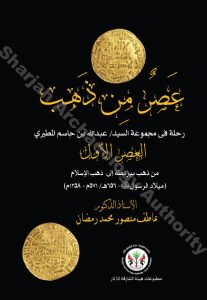Published Date : 2023
Auther : DR Atef Mansour
Publisher : Sharjah Archaeology Authority
Available Languages -
Arabic
Because it represents a specialized academic scientific study of a group of coins preserved in the collection of Mr. Abdullah bin Jassim Al Mutairi, this book (The Golden Age), a journey in the collection of Mr. Abdullah bin Jassim Al Mutairi, is considered one of the most important books in the history of Islamic coinage. The title implies that all of them are gold coins from the time of the Messenger (Peace Be Upon Him) until the fourteenth Hijri century. It is one of over three hundred families and states that have been established in the Islamic land throughout its long history. Hence the choice of the book’s title (The Golden Age) was a witness to the greatness of Islamic civilization for fourteen centuries. The title is a pun. On one hand, it indicates that the Islamic era is a golden age between successive ages of human civilizations. When Islam appeared at the hands of the Messenger (Peace Be Upon Him) in the Arabian Peninsula, it was a watershed in the history of all mankind, as the whole world moved from dark ages dominated by darkness, corruption, polytheism, and deviation from God’s approach to the era of Islam, which came to be a method for the world and the hereafter. It is based on a vast and sprawling civilization that truly represented a golden age in human history.
Rhodian amphora stamps found in Mleiha (Sharjah,UAE): old and recent finds
Published Date : 2022
Auther : Patrick Monsieur / Bruno Overlaet / Sabah A. Jasim / Eisa Yousif / Ernie Haerinck
Publisher : Arabian archaeology and epigraphy
Available Languages -
English
To date Mleiha has yielded eighteen stamps belonging to Rhodian wine amphorae. Eleven of these ...
Umm an-Nar Tomb at Mleiha
Published Date : 2022
Available Languages -
Arabic
The modern town of Mleiha situates about 50 km to the east of Shariah. the ...



